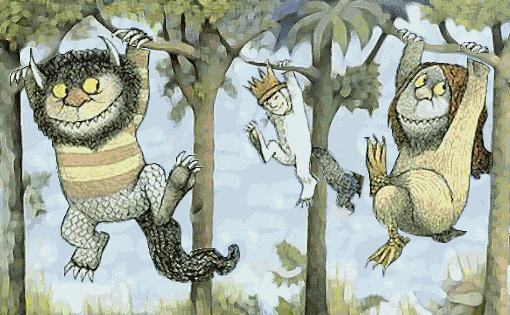Miss Runyan's Reading
Growing Fluency

Wild About Fluency
Growing Reading and Fluency
Rationale:
Reading fluently means that students are no loner reliant on their decoding skills, but on their sight words. In order to promote fluent reading in students, the goal should be for students to read accurately and effortlessly. As fluency increases, students are able to read faster and with expression, and also increase comprehension levels. The most effective practice in improving fluency is repeated readings, which allow students to improve fluency, thereby increasing students’ independence and voluntary reading.
Materials:
Pencils (for every student)
Stopwatch (for every 2 students)
Copy of Where the Wild Things Are for every 2 students
Dry erase board with sample sentences “Anna sang a happy song” & “Luke plays on his drum”
Fluency Progress Chart (one for each student)
Peer Fluency Sheet (one for each student)
Teacher Fluency Sheet (teacher keeps, enough for each student)
Procedures:
1. Say: Today we are going to practice our reading so that we can become fluent readers. Does anyone know what it means to be a fluent reader? (wait for responses) Fluent readers are readers that can read smoothly and quickly. They can do this because they recognize words automatically. When we are able to read words automatically we can better understand the story, which makes reading more enjoyable!
2. Say: Let’s look at the sentence I have written on the board. I am going to read the sentence, and I want you to tell me if I sound like a fluent reader or not. A-a-a-n-n-n-n-a-a-a, Anna, sssss-a-a-a-n-n-n-g-g, sang, a, h-h-a-a-a-p-p-p-p-y-y, happy, sss-a-a-a-n-n-g-g. Anna sang a happy sang. Hmmm, that doesn’t sound quite right. She sang a sang? Wait! Anna sang a happy song! What word did I get stuck on in that sentence? (wait for responses) Right, I got stuck on song. I didn’t say the right sound for /o/. But I used the context of the sentence to figure out the word I wasn’t sure about. This is called crosschecking and it is very important in becoming fluent readers! After I read the entire sentence, I realized that it didn’t make sense! So, I looked for the word that sounded funny, and I saw that I said /a/ instead of /o/. If a word ever sounds funny to you, try crosschecking to see if you can find the right word!
3. Say: Did I sound like a fluent reader when I read that sentence? (wait for responses) I don’t think I did! It took me a long time because I had to sound out all of the words. But, a fluent reader would read the sentence like this: Anna sang a happy song! I read it quick and it was easy to understand. Now its your turn to try! Read the second sentence on the board to your partner again and again until you can do it smoothly (Luke plays on his drum).
4. Say: Today we are going to read Where the Wild Things Are so that we can practice our fluency. This book is about a boy named Max. Now Max was not being good, and he disobeyed his mother. Max gets in trouble and his mother sends him to his room… without dinner!! There is a lot that happens while Max is in his room. What do you think will happen while Max is in his room? To find out, we’ll have to finish the book. Go ahead and read the story silently to yourself one time to figure out what happens to Max.
5. At this time, pass out peer fluency sheets to each student, and give each pair of students a stopwatch.
Say: Now, since you’ve read the story, I want you to get with your partner and demonstrate your fluency skills!! Make sure each partner gets a turn reading pages in the story. I want each partner to read pages 8-10 3 times, and the other partner to time them each reading. Let’s be good partners and kind friends and encourage your partner as they read the pages to you. The first time they read it through, just time them with the stopwatch and listen. For the next two readings, I would like for the listener to time your partner with the stopwatch and listen for a few things: Is your partner reading faster than their last reading? Do they read smoother than their last time? Do they read with expression? Do they remember more words than their last reading? Once you read the pages through 3 times, switch places and let your partner read to you. I’ll be walking around so if you have any questions or need some help, let me know! (*Make sure to teach students how to use the stopwatches; also, walk around the classroom in order to be available to students.)
6. After the students finish, have them come up to your desk, one at a time, and read the allotted pages. Have them to bring up their “peer fluency sheet” so you can add it to the back of the assessment sheet (the Teacher Fluency Check Sheet). Time them on the set pages, and use the formula (below) to calculate how many words per minute the student reads. Ask students questions to assess comprehension of the reading.
Fluency Progress Tracker (move Max up the tree as more words are read)
(click text above)
Words x 60
--------------
Seconds Read
Peer Fluency Sheet
Name of Reader:
Date:
1st Time:
2nd Time:
3rd Time:
My partner…
Read smoother 2nd read 3rd read
Read faster 2nd read 3rd read
Read with expression 2nd read 3rd read
Remembered more words 2nd read 3rd read
Teacher Fluency Check Sheet
Name of Reader:
Date:
Time
Wx60/sec read = _____ WPM
Comprehension Check:
< >What events happened in this section?How does Max get to where the wild things live?Why does Max become the king of the wild things?http://marymargaretbeck1.wixsite.com/missbecksclass/growing-independence-and-fluency
Hooray for Fluency
https://hannahlouiseperkin.wixsite.com/bomblessondesigns/growing-independence-and-fluency
